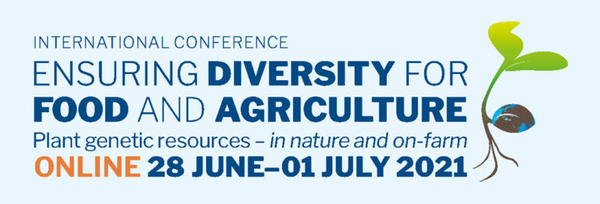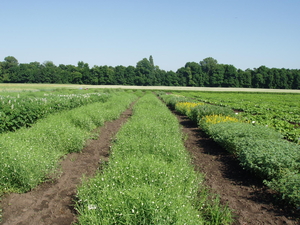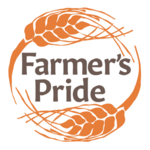Grant Scheme Activities
Phase X
| Sixth Call (2022) | |
| Fifth Call (2021) |
Phase IX
Third Call (2016) |
ECPGR Concept for on-farm conservation and management
of plant genetic resources for food and agriculture
- PDF (723,4 KB)
Working Group activities and related events
February 2024
A landrace threat assessment methodology was published in Frontiers in Plant Science: 'Towards a practical threat assessment methodology for crop landraces', by Maria João Almeida, Ana Maria Barata, Stef de Haan, Bal Krishna Joshi, Joana Magos Brehm, Mariana Yazbek and Nigel Maxted. https://doi.org/10.3389/fpls.2024.1336876
December 2022
The project on 'Inventorying wheat on-farm diversity (INWHEATORY)' – submitted by the On-farm Conservation and Management, and the Wheat Working Groups for funding under the Sixth Call of the Phase X ECPGR Activity Grant Scheme – was selected by the Executive Committee. [more info]
June 2022
Greek local and native agricultural varieties, and their associated knowledge and practices, were inscribed on the National Inventory of Intangible Cultural Heritage of Greece [more info].
April 2022
Partnenopi Ralli, from the Hellenic Agricultural Organization – DEMETER, Greece, was appointed as Vice-Chair of the On-farm Conservation and Management Working Group.
November 2021
The project on “Chances for the conservation and re-cultivation of central European Binkel (club wheat) through a nutritional and genetic differentiation towards other wheat species (BiDifferent)”, submitted by the On-farm Conservation and Management Working Group for funding under the Fifth Call of the ECPGR Activity Grant Scheme for Phase X, was selected by the Executive Committee [more info]
December 2020
The Farmer's Pride announces its final conference and achievements:

The Farmer’s Pride final conference is an opportunity to:
- share knowledge and perspectives
- promote the in situ conservation and sustainable use of plant genetic resources in legislative and governance frameworks
- scale up progress in Europe and other regions with a view to creating a global initiative to safeguard diversity for food and agriculture in the future.
Please note that the Conference could be postponed depending on Coronavirus pandemic trend.
The Farmer’s Pride project achievements at 2020
In situ landrace propagation management and access guidelines
This document provides the user community with clear prescriptions to carry out or develop proper multiplication and diffusion strategies with the principal aim of maximising within landrace diversity while keeping its identity. Cases where introduction of landraces into a completely new environment is needed are also considered. The elements used to build these recommendations were also retrieved through an accurate literature review.
In situ landraces: best practice evidence-base database
This database provides a wealth of information on the benefits, opportunities and methods of landrace cultivation.
In situ plant genetic resources in Europe: landraces
This document reports about extensive data (19,335 records) that have been collected on landrace populations maintained in situ, involving collaborators in the Farmer’s Pride project and members of the European Cooperative Programme for Plant Genetic Resources.
Landrace hotspots identification in Europe
In this document we identify 100 diversity hotspots to be included in a future European network for in situ conservation and sustainable use of plant genetic resources based on the available data relative to 19,335 landrace in situ records from 14 different European countries.
Landrace network design
In this document we report the result of the interaction with Farmer’s Pride Partners and Ambassadors about the identification of activities/sites of landrace cultivation in Europe most relevant for setting the European network for in situ conservation and sustainable use of plant genetic resources with some recommendations on the implementation process.
By examining different types of networks two different sets of criteria are proposed to evaluate the ability of a network in i) securing national and regional LR diversity and ii) facilitating access to landrace material by different users (e.g.farmers, farmers’associations, gardeners, gardeners’associations, seed savers, researchers, NGOs, plant breeders and seed companies).
This document reports the results of the stakeholder analysis carried out in 2018. All countries in the target area (geographic Europe, the EU member states, Türkiye, the Russian Federation, and the Caucasus) were represented, and critically, representatives of all the anticipated main broadly defined stakeholder groups responded to the survey, including independent farmers, protected area managers, seed companies and policymakers. Respondents have interests in all aspects of in situ conservation and sustainable use of plant genetic resources—from national policy development, through capacity building, improving access to material, direct utilization for own consumption or commerce, to research into stress resistance traits, new markets for neglected crops, diversification of grain-based products, and general resilience of humans and the environment. They also work with all types of plant genetic resources, including landraces, crop wild relatives and other wild species, conservation, amateur and obsolete varieties, forage and cereal mixtures, and a range of other types of populations.
October 2018
Assessing linkages between genebanks and direct users (LINKAGES): the Final Activity Report is now available online [here].
June 2018
The final LINKAGES workshop, arranged in collaboration with the EU-funded project Diversifood (www.diversifood.eu) was held 4-5 June 2018 in Florence, Italy. [more info]
May 2018
The Farmer’s Pride project has launched a stakeholder survey.
To help establish a new European network of conservation sites and stakeholders, the project partners are reaching out to identify individuals and organizations involved or with an interest in the conservation of wild and cultivated plant genetic resources (crop wild relatives and traditional local varieties, or landraces), whether in farms, gardens, allotment sites, protected and non-protected areas.
The survey is relevant to all stakeholders, including agro-NGOs, civil society organizations, farmers and gardeners, nature conservation NGOs, plant breeding/seed companies, policy-makers, protected area managers, research institutes, seed/gene banks, and any related networks or other relevant organizations.
July 2017
Farmer’s Pride project accepted
The proposal submitted by the Wild Species Conservation in Genetic Reserves Working Group and the On-farm Conservation and Management Working Group coordinating team (with key additional partners) for H2020 SFS 04 2017 was successful. The project formally starts on the 1st November 2017 and will run for 3 years.
Brief summary:
The overarching objective of Farmer’s Pride is to establish a network of stakeholders and conservation sites that effectively coordinates conservation actions to safeguard the wealth of Europe’s in situ plant genetic resources (PGR) and integrates the user community to maximize their sustainable use. Specifically, to address the challenge and scope of the SFS-04-2017 work programme, Farmer’s Pride will: a) build relationships between existing diverse PGR stakeholder networks, and where necessary create new partnerships to establish a unified network of stakeholders involved in PGR conservation and sustainable use; b) enhance existing knowledge of European landrace and crop wild relative genetic diversity and showcase how it can be effectively secured and managed; c) use social science and economic tools to establish the value of in situ PGR populations and individual traits, as well as a cost effective means of conserving them; d) use predictive characterization methods to identify valuable traits in in situ PGR populations, targeting those most vital for satisfying future agricultural and market needs; e) establish a mechanism to facilitate the flow of plant genetic material from in situ populations to the user community, both directly and via ex situ collections; f) develop and establish a durable governance and resourcing structure for the European network of in situ PGR conservation sites and stakeholders; g) promote public awareness of the value of PGR for agriculture and consumers; and h) design and implement a network of European sites and stakeholders that conserves the breadth of PGR diversity found in situ. Through these activities, Farmer’s Pride will result in significant strengthening of European capacities for the conservation, management and sustainable use of in situ PGR as a foundation for increased competitiveness in the farming and breeding sectors, and ultimately for long-term food and nutritional security in Europe.
May 2017
The “ECPGR Concept for on-farm conservation and management of plant genetic resources for food and agriculture” (723,4 KB) has been published, after approval from the Steering Committee in January 2017.
January 2017
A small kick-off meeting of the project "LINKAGES" was held on 12 January 2017 at Bioversity International, Maccarese, Italy. [more info]
May 2016
The project on “Assessing linkages between genebanks and direct users (LINKAGES)”, submitted by the On-farm Conservation and Management Working Group and Documentation and Information Working Group, for funding under the third call of the ECPGR Activity Grant Scheme, was selected by the Executive Committee.
May 2016
The book “Enhancing Crop Genepool use: Capturing Wild Relative and Landrace Diversity for Crop Improvement” edited by N Maxted, University of Birmingham, UK, M Dulloo, FAO, Italy, B Ford-Lloyd, University of Birmingham, UK, has recently been published and is now available from the following website: http://www.cabi.org/bookshop/book/9781780646138. A discount of 20% will be granted to all ECPGR WG members by using the discount code CCECG20.
2015
- A revised draft of the “ECPGR Concept for on-farm conservation and management of PGRFA diversity in Europe” was submitted to the ECPGR Executive Committee at the beginning of October 2015 by the appointed Task Force. The concept was welcomed as a background paper, but was not considered suitable for approval as such, owing to its length and structure. The Secretariat was asked to develop a more concise document, based on the paper received from the Task Force.
- A few members of the Task Force appointed to develop a concept on “On-farm management and conservation of landraces” convened together with Steering Committee and Executive Committee representatives and the Secretariat in Maccarese, 10-11 March 2015. Points of criticism that had been raised on the draft concept were discussed and an agreement was reached, that the concept should be re-drafted, on the basis of a new outline (11,9 KB). The next version of an “ECPGR concept for on-farm management and conservation of PGRFA” is expected to be prepared by 30 September 2015 for endorsement by the Steering Committee. [more info]
2014
- Enhanced Genepool Utilization ‒ Capturing wild relative and landrace diversity for crop improvement. Joint international conference on utilization and conservation of crop wild relative (CWR) and landrace (LR) diversity for crop improvement of the PGR Secure consortium and the European Association for Research on Plant Breeding (EUCARPIA), 17–20 June 2014, NIAB Innovation Farm, Cambridge, UK.'
Previous years
- 'On the conservation and sustainable use of plant genetic resources in Europe: a stakeholder analysis'. Workshop in Wageningen, November 25–29, 2013
- Landraces Issue No.2. The second of three issues of"Landraces" has been published in October 2013. [more info and previous issue]
- Following the recommendations made by the Thirteenth meeting of the Steering Committee in Vienna (December 2012), a Task Force for “On-farm management and conservation of landraces” has been established to develop agreed concepts at ECPGR level on On-farm management and conservation of landraces.
Working Group operative documents
- Working Group Chair’s report for Phase IX (prepared for the Fifteenth ECPGR Steering Committee Meeting) (see here)
Background information

During the Eleventh Steering Committee meeting (Bosnia and Herzegovina, September 2008) it was recognized that the existing On-farm Conservation and Management Task Force has long-term plans of action and therefore deserved the status of “Working Group". The Task Force was therefore converted into WG.
What is a landrace?
“A landrace is a dynamic population(s) of a cultivated plant that has historical origin, distinct identity and lacks formal crop improvement, as well as often being genetically diverse, locally adapted and associated with traditional farming systems.”
(From: Camacho Villa, T.C., N. Maxted, M.A. Scholten and B.V. Ford-Lloyd. 2005. Defining and identifying crop landraces. Plant genetic resources: characterization and utilization 3(3):373–384).
“A landrace of a seed-propagated crop can be defined as a variable population, which is identifiable and usually has a local name. It lacks “formal” crop improvement, is characterized by a specific adaptation to the environmental conditions of the area of cultivation (tolerant to the biotic and abiotic stresses of that area) and is closely associated with the traditional uses, knowledge, habits, dialects, and celebrations of the people who developed and continue to grow it”.
(Proposed by V. Negri, combining several other definitions).
Related Information
Other Working Group documents and publications
Useful links
National Inventories
International projects
- PGR Secure: Novel characterization of crop wild relative and landrace resources as a basis for improved crop breeding
- EU-funded PGRForum project: European Crop Wild Relative Diversity Assessment and Conservation Forum
- AEGRO: An Integrated European In Situ Management Work Plan: Implementing Genetic Reserves and On Farm Concepts

